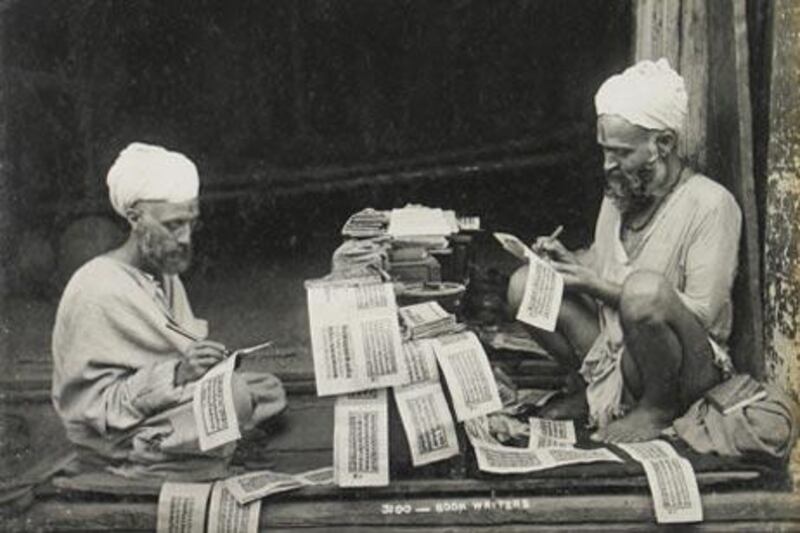It is quite something, amid the gleaming newness of the Dubai International Financial Centre (DIFC), to discover the sort of yellowing, gelatin photographs included in The Empty Quarter's current exhibition. Entitled Sacred Sights, it is a magnificent collection of shots taken in India, dating from the late 19th century up until the present day. The exhibition includes the work of 15 photographers, together with a few anonymous ones, the most recognisable name being Henri Cartier-Bresson. Three examples of his work are here, on loan from the Howard Greenburg Gallery in New York. This is in itself quite a feat, explains the exhibition's curator, Elie Domit, because Cartier-Bresson's widow - the Belgian photograher Martine Franck, who also has work included here - keeps tight control of his photographic legacy.
The three Cartier-Bresson photographs date from his first visit to India in 1948. It was to become an intense relationship for him and he subsequently spent prolonged periods of time in the country. This first visit coincided with Gandhi's funeral, an enormously intense occasion for the newly independent country, and one to which Cartier-Bresson was given the highest access. One of the shots shows the wide-eyed prime minister, Jawaharlal Nehru, standing in a crowd. Another reveals the indiscriminate scope of Cartier-Bresson's roaming lens on the same trip, with the backs of several women peering out across the Kashmir hills.
There are several scenic shots and colourful, albumen Indian miniatures here, but it is the exhibition's stark portraits that touch the most. There are endless clichés tossed out about India, one of the most common being that is a country of contradictions. But Sacred Sights cuts through the waffle often written and portrayed on the subject by showing very raw, real images of its people. There is a magnificent, misty shot of morning bathers gathered alongside a lake in the the ancient Rajasthani city of Pushkar in 1975, taken by the French photographer Bruno Barbey. He is a master in the use of colour in images, with the bright oranges of turbans radiating out in another of his Pushkar photographs included.
Opposite is one of several 1970s shots by the American photographer Mary Ellen Mark of Mumbai's red-light district on Falkland Road, the women's faces staring through the bars of their display cages. More moving is a shot by the American Margaret Bourke-White, the first female photojournalist on Life magazine, the first western photographer allowed into the Soviet Union in 1930 and the first female photographer to be allowed into combat zones during the Second World War.
She was in India in 1947 to witness the devastating uprooting caused by partition, as shown in this exhibition by a frame of an overladen Sikh family trudging north, with a small boy slumped on the shoulders of another. Bourne and Shepherd has a presence too. It is the world's oldest photographic studio still in operation today, originally set up by two British photographers in the mid-19th century in India and now run from Kolkata. Their black and white photographs are the oldest in the exhibition, showing India when it was still the jewel of the British imperial crown.
One, entitled Weighing Opium, is particularly revealing. Indian men sit on the floor around a set of scales, while an unidentified British sahib stands over them in white safari hat, breeches and with a pipe hanging from his mouth. Another cliché, perhaps, but a telling one. Others from the same studio include a shot of men, women and children at the foothills of the Himalayas, all gathered behind several large baskets full of tea-leaves.
Of the more contemporary shots, there are humorous glimpses. Most of these come from the lens of Betsy Karel, an American-based photojournalist who has made several journeys to Mumbai in the past decade for a book project. Entitled Bombay Jadoo (jadoo is Hindi for magic), the black and white photographs illustrate the country's transition. There are shots of the middle classes on the beach, of Bollywood, one of a railway carriage with two women smiling next to a sign reading "Ladies Only For All The Twenty Four Hrs".
Best of all, perhaps, is the frame of a man sitting near the Gate of India on the Mumbai shoreline. There he rests, head lolling back alongside two dogs similarly flopped out, the trio united in mutual exhaustion. The backdrop of the Taj Mahal Hotel perhaps serves as a fitting metaphor for the durability and grit of the country itself. Sacred Sights is at The Empty Quarter in the DIFC until February 5 (www.theemptyquarter.com).





